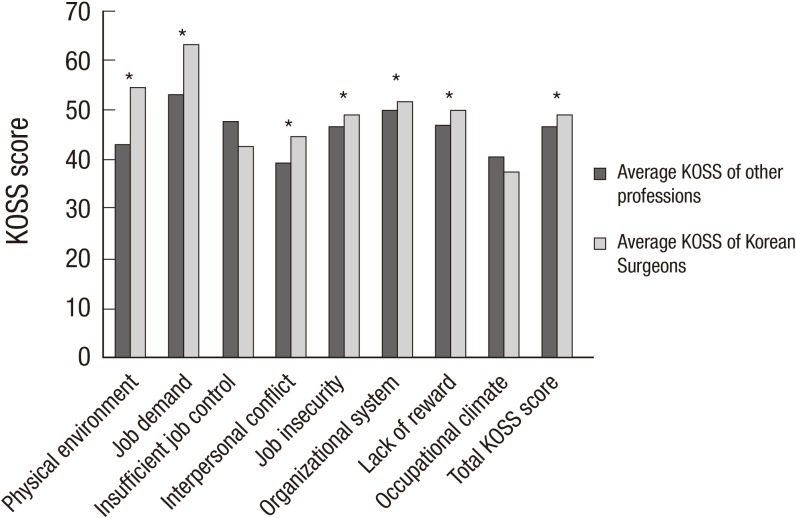Abstract
Surgery is a demanding and stressful field in Korea. Occupational stress can adversely affect the quality of care, decrease job satisfaction, and potentially increase medical errors. The aim of this study was to investigate the occupational stress and career satisfaction of Korean surgeons. We have conducted an electronic survey of 621 Korean surgeons for the occupational stress. Sixty-five questions were used to assess practical and personal characteristics and occupational stress using the Korean occupational stress scale (KOSS). The mean KOSS score was 49.31, which was higher than the average of Korean occupational stress (45.86) or that of other specialized professions (46.03). Young age, female gender, long working hours, and frequent night duties were significantly related to the higher KOSS score. Having spouse, having hobby and regular exercise decreased the KOSS score. Multiple linear regression analysis showed that long working hours and regular exercise were the independent factors associated with the KOSS score. Less than 50% of surgeons answered that they would become a surgeon again. Most surgeons (82.5%) did not want to recommend their child follow their career. Korean Surgeons have high occupational stress and low level of career satisfaction.
Graphical Abstract
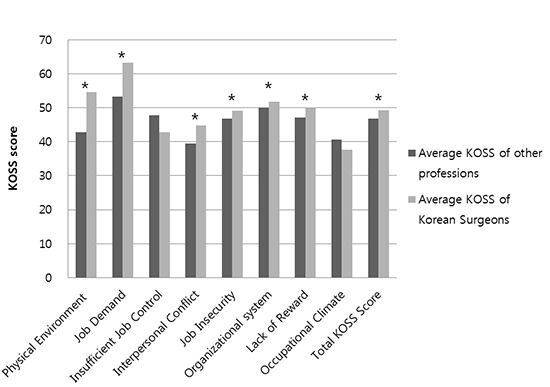
Keywords: Occupational Stress, Surgeon, Physicians, Career Satisfaction, Working Hours, Exercise, Burnout
INTRODUCTION
A surgeon is a medical doctor with the trained specialty to operate in need of variety of surgical procedure. Surgery involves the core treatment of most of diseases such as cancer, acute care, trauma, reconstructive medicine and even transplantation. Therefore, the importance of a surgeons' role cannot be emphasized enough in our health care service. In other countries, surgery is one of the most popular specialties as a meaningful and rewarding job for medical doctors. However, in Korea, a surgeon became a job that most doctors want to avoid as their life-time specialty. There are numerous reasons that can be considered as factors related to this trend in Korea such as low insurance costs for surgical procedures, an increased workload for the individual surgeon due to the shortage of workforce, risk of medical sue and others. One of the main reasons is the high workload and occupational stress of Korean surgeons (1).
The work in an operating room can be stressful, hectic and physically demanding. Surgery is sometimes an emergency event, performed in a high pressure, life-or-death situation. Surgeons typically work long hours and may also take emergency calls. In addition, they may need to work when they are sleep-deprived and often work under stress (2).
Previous research showed that extreme stress leads to the burnout of a surgeon, which subsequently contributes to an impaired technical performance, medical errors, physical and also mental health problems, and even to an increased risk of suicide (3, 4).
In other countries, a number of studies have been conducted to report on the high level of stress and reduced job satisfaction in surgeons and physicians as well (5, 6, 7). However, there has been no study investigating on the occupational stress of surgeons in Korea yet. This is the first study to examine occupational stress, burnout and career satisfaction of surgeons in Korea.
We conducted a survey in the membership of the Korean Surgical Society to evaluate the occupational stress and to analyze the working conditions and personal characteristics associated with a high occupational stress level.
The aim of this study was to evaluate the level of occupational stress of Korean surgeons compared to other professions and to investigate relating factors based on an electronic survey.
MATERIALS AND METHODS
Subjects and data collection
All surgeons who were members of the Korean Surgical Society with an e-mail address on file were eligible to participate in this study. The participation was completely voluntary and all responses were anonymous. The study was commissioned by the Korean Surgical Society and under oversight of the institutional review board (IRB) of the Korea University Anam hospital.
All surgeons were electronically surveyed in October 2012. A cover letter stated that the purpose of the survey was to evaluate the stress level and to better understand the factors contributing to the stress of surgeons. Up to 4 follow-up e-mail messages reminded the surgeons to complete the survey. The survey was made up of 65 questions including the full version of the Korean occupational stress scale (KOSS), the subscale of the Maslach burnout Inventory, and additional questions addressing demographic information, lifestyle variables, working conditions, stress reactions/coping strategies and job satisfaction (Appendix 1). The KOSS is a validated tool of the National Study for Development and Standardization of Occupational Stress in Korea to measure the level of occupational stress as we previously described in our pilot study (8, 9).
Burnout was measured using 2 single-item measures adopted from the full Maslach Burnnout Inventory subscales (10). We considered surgeons with high scores on either the depersonalization and/or emotional exhaustion subscales as having a professional burnout (11, 12).
Statistical analysis
The KOSS score is expressed as mean±standard deviation. We used the KOSS scores of other professions in the report of the Korean Occupational Safety and Health Agency, conducted in 2005, to compare surgeon's stress scale with the scales of other professions (9, 13).
The comparison of mean KOSS scores between groups regarding baseline demographics, life style variables, burnout and career satisfaction was performed using Student's t-test and one-way variance of analysis, followed by Tukey's post hoc test if appropriate. Also multivariate linear regression analysis was performed to find out most reliable factors related to occupational stress. In all analysis, P value<0.05 was interpreted as statistically significant. All statistical analyses were performed using SPSS version 20.0 (IBM, Armonk, NY, USA).
Ethics statement
This study protocol was approved by the institutional review board of Korea University Anam Hospital (IRB No. ED12211). Informed consent was waived by the board.
RESULTS
Survey evaluation
Of the members and associated members of the Korean Surgical Society, 4,294 had available e-mail addresses on the record for the correspondence. Of these 4,294 surgeons who were surveyed, 621 (14.5%) participated in this study.
Demographics, Professional and Life style characteristic, and KOSS
The mean KOSS score of the survey was 49.31±9.95, which was higher than that of other specialized professions (46.03, P<0.001) or that of the average Korean KOSS score (45.86, P<0.001). Fig. 1 shows the difference of KOSS scores between Korean surgeons and other specialized professionals in Korea. Among the eight subscales of occupational stress, Korean surgeons had significantly higher scores than other specialized jobs in subscales of physical environment (P<0.001), job demand (P<0.001), interpersonal conflict (P<0.001), job insecurity (P=0.001), organizational system (P=0.003) and lack of reward (P<0.001). However, for insufficient job control and occupational climate, Korean surgeons showed lower KOSS compared to other professionals (P<0.001).
Fig. 1.
Comparison of Korean Occupational Stress Scale (KOSS) score of Korean surgeons with other professions: All categories. *Korean surgeons had significantly higher scores than other specialized jobs (P value < 0.05).
The personal and practical characteristics of the study participants and average KOSS scores according to these characteristics are summarized in Table 1. Young age (P<0.001) and female gender (P<0.001) were significantly related to a higher KOSS score. Married surgeons had a lower KOSS score than un-married surgeons (P<0.001). Surgeons in training (residents) showed a higher KOSS score than other surgeons (P<0.001). Long working hours (P<0.001), higher mean number of patients (P<0.001) and frequent night duties per weak (P<0.001) were positively correlated with a higher KOSS. When we analyzed the data according to the subspecialty, breast and endocrine surgeons (46.69±9.97) had the lowest stress score, but there was no significant difference between the subspecialties.
Table 1.
Characteristics of the responding Korean surgeons
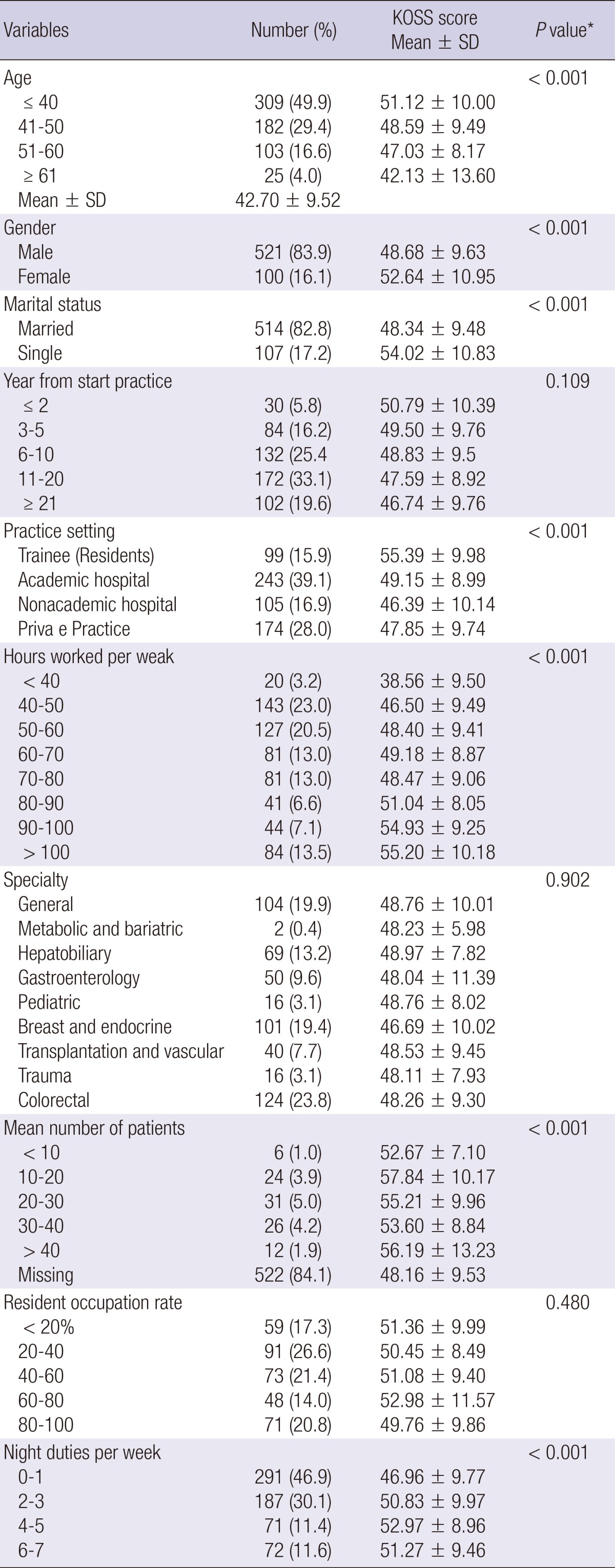
Values are mean ± SD or number of patients (%).
*P values by ANOVA or Student's t-test as appropriate.
We investigated several life style variables to find out if they are related to the occupational stress (Table 2). Smoking and drinking habits were not related to the occupational stress. However, surgeons who are doing regular exercise (more than 2 days per week for >30 min) showed a significantly lower KOSS score (P<0.001). Moreover, having a hobby was also strongly related to a lower KOSS score (P=0.002).
Table 2.
Life style variables of responding Korean surgeons
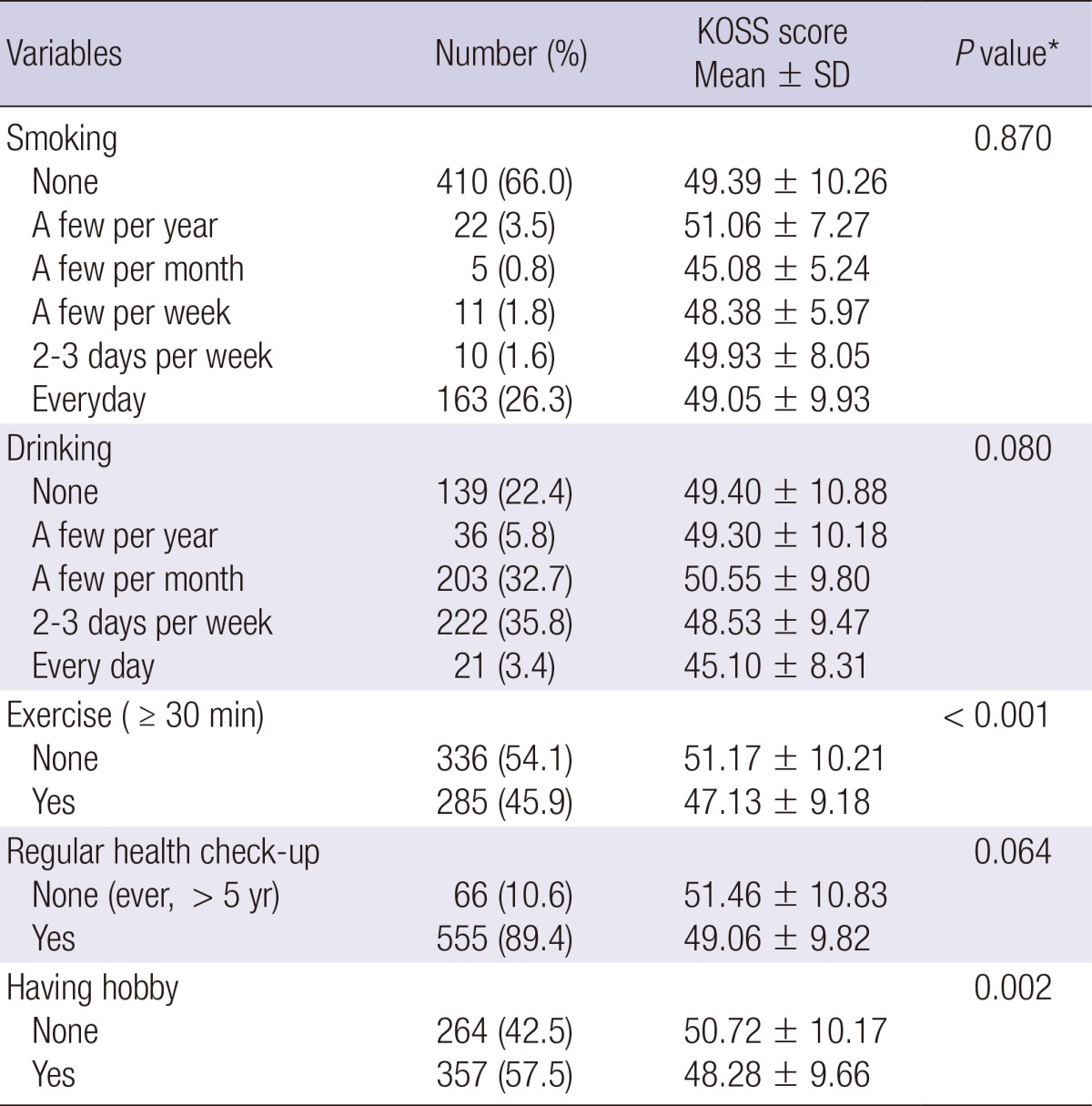
Values are mean ± SD or number of patients (%).
*P values by ANOVA or Student's t-test as appropriate.
When we implemented multiple linear regression analysis on all variables which were significantly related to occupational stress in the univariate analysis, long working hours and exercise were factors independently associated with occupational stress of Korean surgeons (Table 3).
Table 3.
Multiple linear regression analysis for KOSS
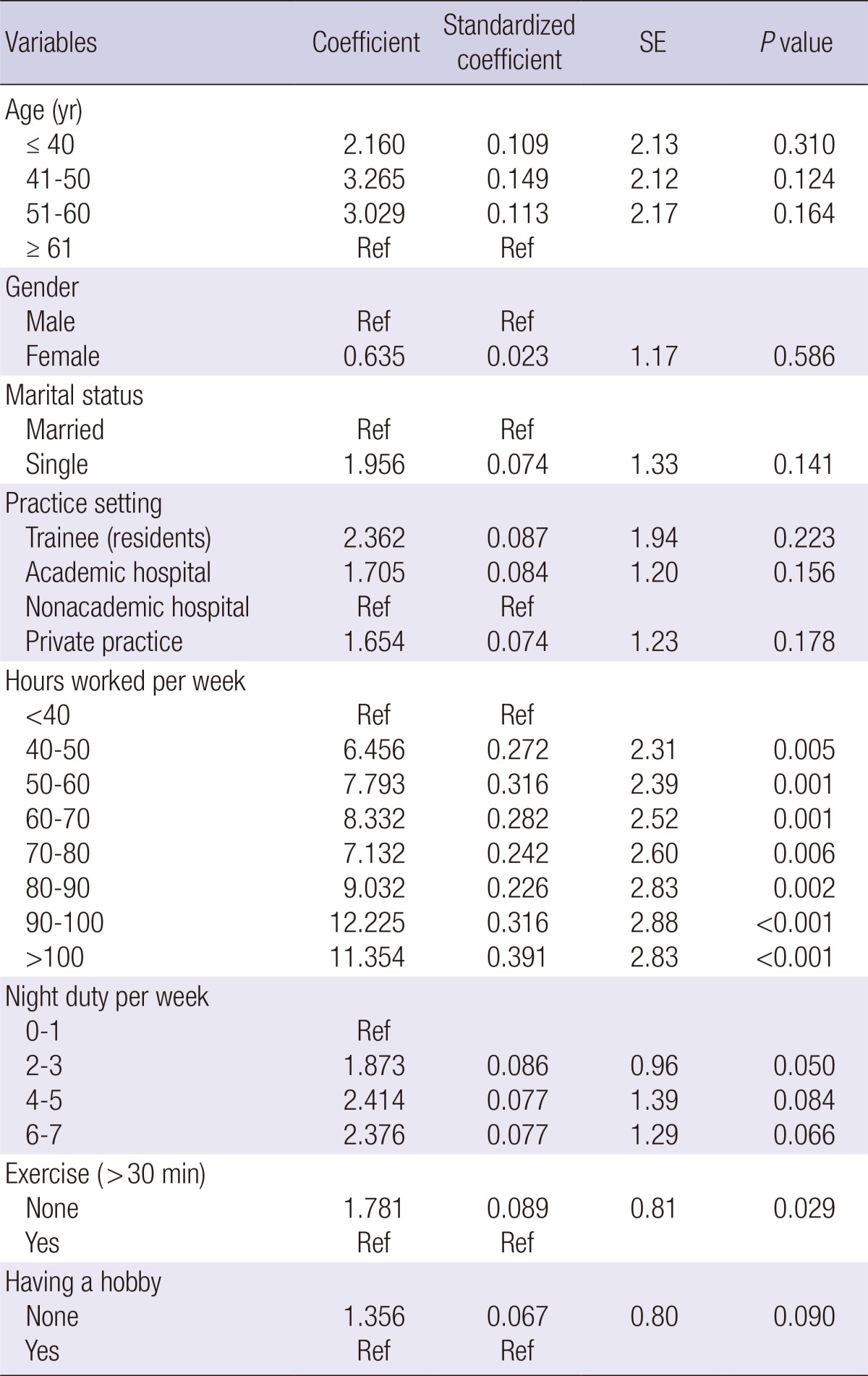
Burnout and KOSS
Characteristics of responding surgeons with respect to burnout are summarized in Table 4. 16.6% showed high emotional exhaustion, and 28.5% had a high score of depersonalization. Overall, 197 surgeons (31.7%) were considered to suffer from burnout and these surgeons had a much higher KOSS score (55.34±9.69) than those surgeons without burnout (46±8.77) (P<0.001).
Table 4.
Burnout and KOSS of Korean surgeons
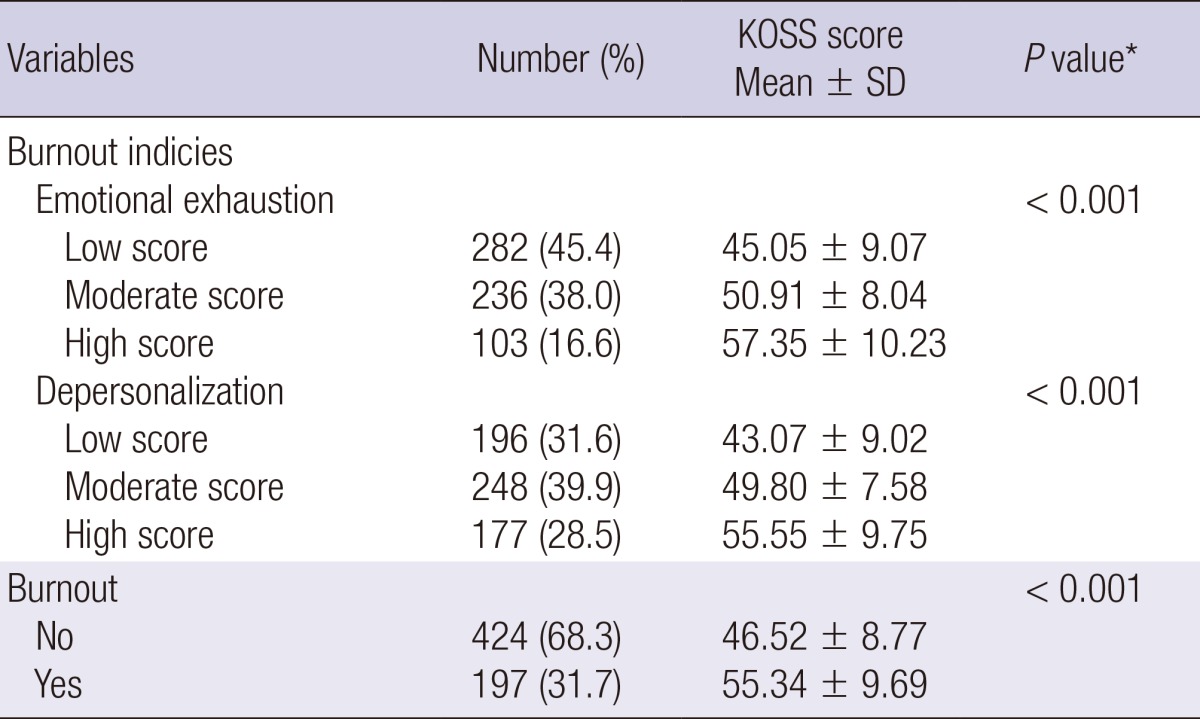
Values are mean ± SD or number of patients (%).
*P values by ANOVA or Student's t-test as appropriate.
Career satisfaction of Korean surgeons
Table 5 depicts the responses to the questions on career satisfaction. A considerable proprtion of surgeons that responded to this survey indicated that they would become a physician again (64.1%). However, the percentage of a positive answer (49.4%) was decreased when they were asked, "would become a surgeon again". Intriguingly, most surgeons (82.5%) do not want to recommend their career to their child. Also, surgeons with a low career satisfaction showed a higher occupational stress level (P<0.001).
Table 5.
Career satisfaction of Korean surgeons
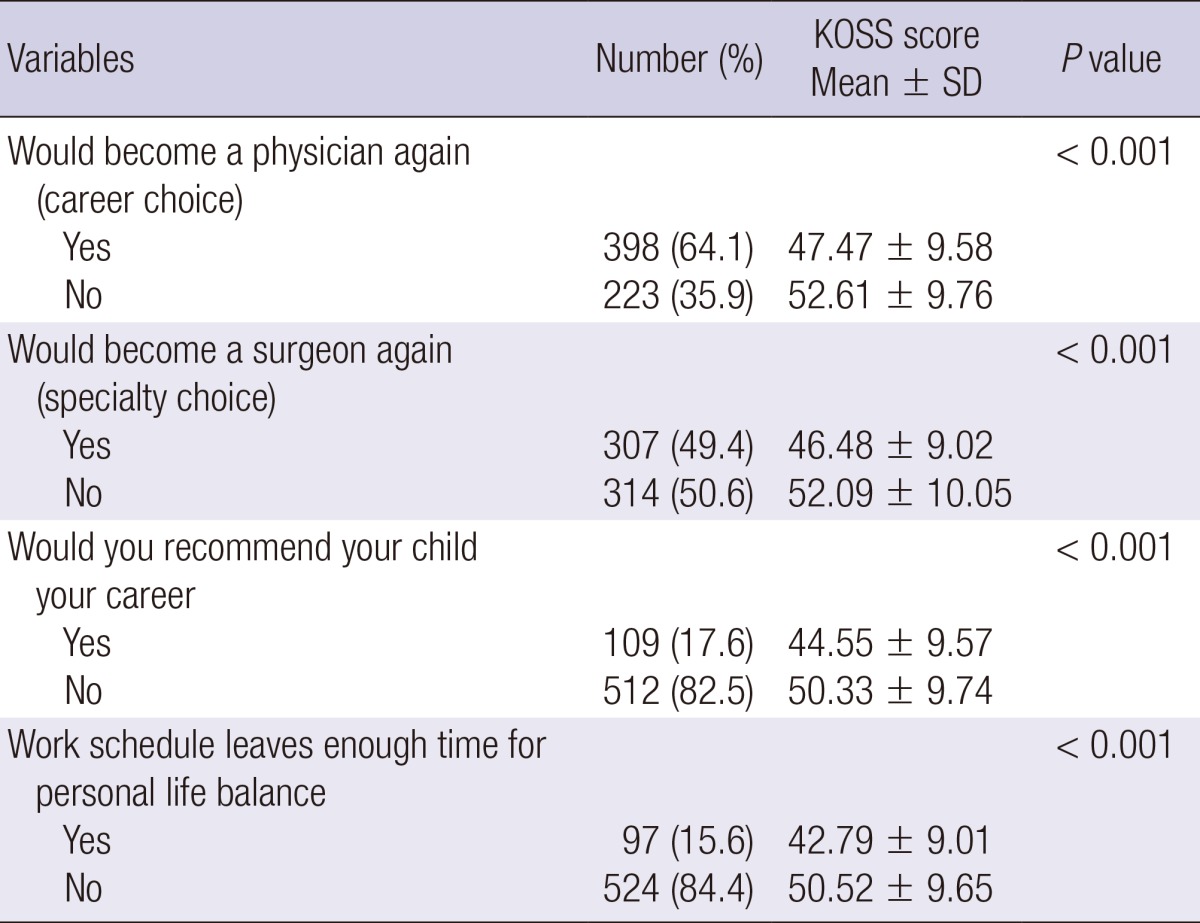
DISCUSSION
This is the first national survey that analyzing the occupational stress of surgeons in Korea. In our previous pilot study for occupational stress of surgeons, they showed higher occupational stress than other professions (9). As we expected, the level of occupational stress of Korean surgeons was significantly higher than that of other professions. In the subscale analysis of KOSS, Korean surgeons showed higher scales in terms of physical environment, job demand, job insecurity, organizational system, and lack of reward. It implies that working environments of surgeons are demanding and not so feasible, and the rewards are not sufficient to overcome those circumstances. These results are consistent with the results of our survey for career satisfaction. More than half of surgeons (50.7%) said that they would not become a surgeon again, and also the majority of them (84.4%) felt that they are not able to balance their personal life and work. Intriguingly, most of the responding surgeons (82.5%) said that they would not recommend their career to their children. This probably means that they think the future prospect of surgeons is not promising any more. Those gloomy results suggest that there exist a great problems in the working environment of the surgeons. Moreover, these results are strikingly contrasting to the results of the US surgeons where 74% of surgeons answered they would become a surgeon again and 51% would recommend their children to pursue a career as a surgeon (12). A high level of dissatisfaction at work could give a tremendous amount of bad influence not only to the public health system but also to the quality of medical service (14, 15). Therefore, we should have face such unfavorable results of high stress levels and low satisfaction rates in Korean surgeons, and try to manage this circumstances as soon as possible in the academic society as well as in a national health dimension.
We used the Korean occupational stress scale to evaluate the occupational stress because the KOSS developed by the National study for Development and Standardization of Occupational Stress (NSDSOS Project:2002-2004), is considered to be not only more suitable for the evaluation of stress in Korean employees but also able to be able to compare to the previous results of average Korean employees and other professions (13, 16). However, we also investigated the Maslach burnout indices which were widely used in other countries in order to obtain the burnout rate and the relation to the KOSS score of this group of peoples (12). We found nearly 32% of surgeons meeting the criteria of burnout, which is a considerable high rate compared to the general population (about 25%). Also these group of surgeons showed a high KOSS score (Table 4) (16). These results suggest that high KOSS score is closely related to burnout which is reliable tools to measure the occupational stress of medical employee (2). Considering a previous report indicating that medical errors are significantly correlated to burnout, this is a warning sign that patient safety in our health care system could be adversely affected (14, 17).
We further analyzed our data to see relating factors to the occupational stress of Korean surgeons. Young age and female gender were found to be related to a high KOSS. In the previous study on the US surgeons, young age was associated with a high risk of burnout which is consistent with our result (18). They explained that younger surgeons are at higher risk of burnout because they usually have young children in their personal life and also spent more nights on call per week than older surgeons (12, 19). Female surgeons showed a significantly higher KOSS score in univariate analysis in our study. Benson et al. (20) assessed burnout of Australian surgical trainees and fellows, and found that women had a higher level of burnout compared with their male colleagues. This also has been previously reported by Kuerer et al. (21) in a study of American surgical oncologists, but they did not find out the exact reason for this gender discrepancy. In addition, generally is the surgical field a male domain, and a much smaller portion of female respondents was included in most studies. This probably made it more difficult to analyze the exact reason. Our study had a small population of female surgeons (16.1%) also, and female gender was not significantly associated with a high KOSS in multiple logistic regression analysis. Women surgeon showed higher scores in most of the subscales of KOSS, however, women showed particularly higher score in the occupational climate among the subscales of KOSS (data not shown). This result suggests Korean women surgeon suffer more from the culture and atmosphere of their work. The reasons are not clear, but there may be more stress factors in social, cultural and occupational environments for women surgeons.
Among the subspecialties of surgeons, breast and endocrine surgeons had the lowest level of occupational stress. The result is not surprising because breast and endocrine surgeons are usually not frequently confronted with life and death events or frequent night time calls for emergencies compared to other subspecialties. However, there was no significant difference between the subspecialty.
Other factors were associated with KOSS in the practical characteristics and lifestyle variable analysis are long working hours, high numbers of assigned patient, and frequent night time duty, having spouse, having hobby and exercise. Intriguingly, long working hours and regular exercise were independently associated factors showing a meaningful difference on the KOSS score in the multiple linear regression analysis.
Long working hours has been raised as an important factor associated with high occupational stress and burnout (2). Although the total number of working hours by surgeons has not been found to be an independent predictor of occupational stress and burnout in most studies, the higher number of working hours with more than 60 hr per week for the majority of surgeons contrasts to average workers has been indicated as a problem (11). In our study, 53% of surgeons worked more than 60 hr a week, 26% of surgeons worked more than 80 hr a week and strikingly, 14% of surgeons worked more than 100 hr a week. Considering that the average working hours of Korean employees are about 40 hr per week, these extraordinarily long working hours can be a hazardous factor that adversely affects the mental and physical health of surgeons. Contrasting to other studies, the number of working hours is the independent predictor of occupational stress for Korean surgeons in our study. Interestingly, the more hours surgeons work per week, the significantly higher KOSS score surgeons have. This result suggests that the high number of working hours is the most crucial factor and we should try to improve such situation to lessen the occupational stress of Korean surgeons.
Regular exercise was also an independent predictor associated with low occupational stress in our study. There have been many previous studies suggesting the positive effect of exercise (11, 22). Also our previous pilot study showed the significant relation between regular exercise and a low KOSS score (9). Childs and de Wit (22) studied the association of regular exercise and emotional resilience to acute stress and suggested that regular exercise protect against the negative emotional consequences of stress. Gerber et al. (16) also reported that aerobic exercise has the potential to reduce stress and prevent the development of burnout. It is cardinal to try to find out and reduce the cause of occupational stress, however, the adequate management of stress is another important factor that could decrease the occupational stress. According to the results of our study, of many stress coping strategies, regular exercise can be recommended as one of the most powerful way to reduce the occupational stress. Therefore, it is important to focus on the support for surgeons in their daily life stress coping management such as with regular exercise. Encouraging exercise and giving them an accessible facility in the working environment could be the very effective and easy way to decrease their occupational stress.
Our study has some limitations. First, our survey had a low response rate of 14.5%. This was relatively lower than for other surveys performed in physicians and surgeons in other countries. Despite the possibility of response bias increase, several studies failed to identify significant differences between respondents and nonrespondents (23). In addition, the response rate is not too low to represent Korean surgeons taking in account that only two third of active practicing surgeons are registered members of Korean surgical society. The second limitation is that we used a shortened version of Maslach burnout inventory. The reason is that the full version would have been too long to complete for the surgeons and would have been lowered the response rate. Therefore, we used two single item measures for the burnout evaluation because many previous studies showed that high scores for medical professionals on emotional exhaustion, and depersonalization subscales are indicators for a professional burnout (11, 21).
This study has a great meaning as a first large-scale survey for Korean surgeons evaluating occupational stress and career satisfaction. Our survey used the KOSS with standardized measures of occupational stress of a large scaled national study and facilitated the comparison of average Korean employees. Moreover, we have extensively investigated variable factors related to practical and personal life style characteristics and found out meaningful factors related to occupational stress in Korean surgeons.
In conclusion, Korean surgeons experience high occupational stress and low career satisfaction. Young age, female gender, no spouse, long working hours, high numbers of assigned patients and frequent night duties are correlated with high occupational stress. However, having hobby and regular exercise is significantly related to low occupational stress. Of all factors, long working hours and regular exercise were the most crucial factors associated with occupational stress in Korean surgeons. Considering the steep declining number of applicants for surgeon in Korea, it is critical to pay continuous attention and effectively manage this high occupational stress and low satisfaction rate of Korean surgeons by recommending some relaxing activities.
Footnotes
Funds received from the Korean Surgical Society (2012 Research fund) were used to cover the administrative costs of performing the survey, data entry, and statistical analysis.
No potential conflict of interest has to be reported relevant to this article.
Conceived and designed the experiments: Boo YJ, Kang SH. Performed the surveys: Boo YJ, Kang SH, Han HJ. Analyzed the data: Lee JS, Kang SH, Boo YJ. Contributed materials/analysis tools: Kang SH, Kim CS, Jung CW. Wrote the first draft of the manuscript: Boo YJ. Wrote the paper: Boo YJ, Kang SH. ICMJE criteria for authorship read and met: Boo YJ, Kang SH, Lee JS, Han HJ, Jung CW, Kim CS. Agree with manuscript results and conclusions: Boo YJ, Kang SH, Lee JS, Han HJ, Jung CW, Kim CS.
Appendix 1.
Questionnaires
References
- 1.Kim SK. How to save surgical residents in crisis. J Korean Surg Soc. 2009;76:207–214. [Google Scholar]
- 2.Balch CM, Shanafelt T. Combating stress and burnout in surgical practice: a review. Thorac Surg Clin. 2011;21:417–430. doi: 10.1016/j.thorsurg.2011.05.004. [DOI] [PubMed] [Google Scholar]
- 3.BAner JG, 4th, Khan Z, Babu M, Hamed O. Stress, burnout, and maladaptive coping: strategies for surgeon well-being. Bull Am Coll Surg. 2011;96:17–22. [PubMed] [Google Scholar]
- 4.Harms BA, Heise CP, Gould JC, Starling JR. A 25-year single institution analysis of health, practice, and fate of general surgeons. Ann Surg. 2005;242:520–526. doi: 10.1097/01.sla.0000184223.76854.29. discussion 6-9. [DOI] [PMC free article] [PubMed] [Google Scholar]
- 5.Yeo H, Viola K, Berg D, Lin Z, Nunez-Smith M, Cammann C, Bell RH, Jr, Sosa JA, Krumholz HM, Curry LA. Attitudes, training experiences, and professional expectations of US general surgery residents: a national survey. JAMA. 2009;302:1301–1308. doi: 10.1001/jama.2009.1386. [DOI] [PubMed] [Google Scholar]
- 6.Sameer-ur-Rehman, Kumar R, Siddiqui N, Shahid Z, Syed S, Kadir M. Stress, job satisfaction and work hours in medical and surgical residency programmes in private sector teaching hospitals of Karachi, Pakistan. J Pak Med Assoc. 2012;62:1109–1112. [PubMed] [Google Scholar]
- 7.Weinstein DF. Duty hours for resident physicians--tough choices for teaching hospitals. N Engl J Med. 2002;347:1275–1278. doi: 10.1056/NEJMsb022065. [DOI] [PubMed] [Google Scholar]
- 8.Chang SJ, Koh SB, Kang D, Kim SA, Kang MG, Lee CG, Chung JJ, Cho JJ, Son M, Chae CH, et al. Developing an occupational stress scale for Korean employees. Korean J Occup Environ Med. 2005;17:297–317. [Google Scholar]
- 9.Kang SH, Boo YJ, Lee JS, Ji WB, Yoo BE, You JY. Analysis of the occupational stress of Korean surgeons: a pilot study. J Korean Surg Soc. 2013;84:261–266. doi: 10.4174/jkss.2013.84.5.261. [DOI] [PMC free article] [PubMed] [Google Scholar]
- 10.Maslach C, Jackson SE. The measurement of experienced burnout. J Organ Behv. 1981;2:99–113. [Google Scholar]
- 11.Shanafelt TD, Oreskovich MR, Dyrbye LN, Satele DV, Hanks JB, Sloan JA, Balch CM. Avoiding burnout: the personal health habits and wellness practices of US surgeons. Ann Surg. 2012;255:625–633. doi: 10.1097/SLA.0b013e31824b2fa0. [DOI] [PubMed] [Google Scholar]
- 12.Shanafelt TD, Balch CM, Bechamps GJ, Russell T, Dyrbye L, Satele D, Collicott P, Novotny PJ, Sloan J, Freischlag JA. Burnout and career satisfaction among American surgeons. Ann Surg. 2009;250:463–471. doi: 10.1097/SLA.0b013e3181ac4dfd. [DOI] [PubMed] [Google Scholar]
- 13.Cho JJ, Kim JY, Chang SJ, Fiedler N, Koh SB, Crabtree BF, Kang DM, Kim YK, Choi YH. Occupational stress and depression in Korean employees. Int Arch Occup Environ Health. 2008;82:47–57. doi: 10.1007/s00420-008-0306-4. [DOI] [PubMed] [Google Scholar]
- 14.Balch CM, Oreskovich MR, Dyrbye LN, Colaiano JM, Satele DV, Sloan JA, Shanafelt TD. Personal consequences of malpractice lawsuits on American surgeons. J Am Coll Surg. 2011;213:657–667. doi: 10.1016/j.jamcollsurg.2011.08.005. [DOI] [PubMed] [Google Scholar]
- 15.Shanafelt TD, Novotny P, Johnson ME, Zhao X, Steensma DP, Lacy MQ, Rubin J, Sloan J. The well-being and personal wellness promotion strategies of medical oncologists in the North Central Cancer Treatment Group. Oncology. 2005;68:23–32. doi: 10.1159/000084519. [DOI] [PubMed] [Google Scholar]
- 16.Gerber M, Brand S, Elliot C, Holsboer-Trachsler E, Pühse U, Beck J. Aerobic exercise training and burnout: a pilot study with male participants suffering from burnout. BMC Res Notes. 2013;6:78. doi: 10.1186/1756-0500-6-78. [DOI] [PMC free article] [PubMed] [Google Scholar]
- 17.West CP, Tan AD, Habermann TM, Sloan JA, Shanafelt TD. Association of resident fatigue and distress with perceived medical errors. JAMA. 2009;302:1294–1300. doi: 10.1001/jama.2009.1389. [DOI] [PubMed] [Google Scholar]
- 18.Balch CM, Shanafelt TD. Burnout among surgeons: whether specialty makes a difference. Arch Surg. 2011;146:385–386. doi: 10.1001/archsurg.2011.53. [DOI] [PubMed] [Google Scholar]
- 19.Balch CM. Comanaging an organ transplantation and melanoma. Arch Surg. 2011;146:1347–1348. doi: 10.1001/archsurg.2011.997. [DOI] [PubMed] [Google Scholar]
- 20.Benson S, Sammour T, Neuhaus SJ, Findlay B, Hill AG. Burnout in Australasian Younger Fellows. ANZ J Surg. 2009;79:590–597. doi: 10.1111/j.1445-2197.2009.05012.x. [DOI] [PubMed] [Google Scholar]
- 21.Kuerer HM, Eberlein TJ, Pollock RE, Huschka M, Baile WF, Morrow M, Michelassi F, Singletary SE, Novotny P, Sloan J, et al. Career satisfaction, practice patterns and burnout among surgical oncologists: report on the quality of life of members of the Society of Surgical Oncology. Ann Surg Oncol. 2007;14:3043–3053. doi: 10.1245/s10434-007-9579-1. [DOI] [PubMed] [Google Scholar]
- 22.Childs E, de Wit H. Regular exercise is associated with emotional resilience to acute stress in healthy adults. Front Physiol. 2014;5:161. doi: 10.3389/fphys.2014.00161. [DOI] [PMC free article] [PubMed] [Google Scholar]
- 23.Kellerman SE, Herold J. Physician response to surveys. A review of the literature. Am J Prev Med. 2001;20:61–67. doi: 10.1016/s0749-3797(00)00258-0. [DOI] [PubMed] [Google Scholar]
Associated Data
This section collects any data citations, data availability statements, or supplementary materials included in this article.
Supplementary Materials
Questionnaires



